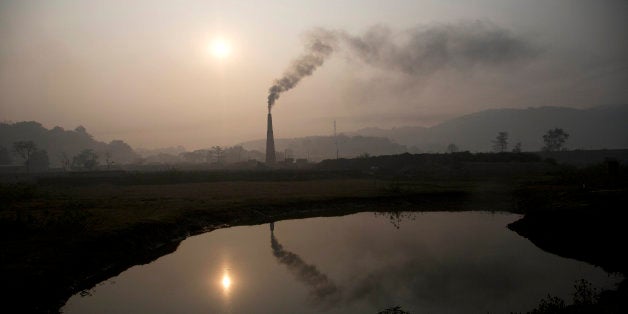
James Lovelock's search for life on Mars led him to conclude that the gases in a planet's atmosphere indicated whether it harboured life or was dead. Through a series of complicated evolutionary dance steps life contrives to keep a planet habitable for life. Whether that life is intelligent or not is another matter.
Any extra-terrestrial observing Earth would conclude something momentous happened to our own atmosphere in the last 60 years. A continent sized hole appeared in the ozone layer - the layer that protects life from harmful radiation. The delicate balance of greenhouse gases started rising rapidly. The most important, carbon dioxide, rose rapidly from 280 parts million in the 18th century to 400 parts per million this year - a 43% shift. Unsurprisingly the planet's temperature went up a notch (1°C or 1.8°F).
ET might conclude some rogue species has taken over and grown like a cancer out of control. They might be right. He would certainly put a watching brief on the third rock from the sun and will be wondering what happens next. Will Earth go into shock and enter a feedback loop where warming begets more warming and flips to an extreme Venus-like state? Or will we see another feedback loop where the information about the state of the biosphere feeds back to the perpetrators who can act on this information and moderate behaviour?
If the aliens are monitoring the airwaves from the Paris climate summit this week they may well be surprised by the news that the growth rate of emissions of carbon dioxide look like they are stalling. Indeed, scientists from the Global Carbon Project say in 2014 emissions grew just 0.6% compared with a 2.4% annual increase over the last decade. Incredibly, they predict emissions rates might actually decline in 2015 by 0.6% (with an uncertainty range of between -1.5% and +0.5%). This is unprecedented during global economic growth and was certainly not predicted by the same researchers back in 2014.
China's decreased coal use can take large credit for this shift. After rising 6.7% annually for the previous decade, China's emissions growth slowed to 1.2% in 2014 and it is expected to decrease in 2015. Last year, renewable energy contributed to over half of China's new energy needs.
The other reasons for the slowdown include slower growth in petroleum use and faster growth in renewables. This is of course a momentous achievement at a critical time.
While growth in emissions may well be hovering around zero for now, the researchers do not expect this to last. All eyes are on India. India was the fourth biggest emitter of CO2, behind China, the US and Europe (7.2 per cent of the world total). But India's emissions today match those of China in 1990, just before China's economy and emissions went into overdrive.
India's economy is set to take off. On current trends, in 2-3 years, India's emissions will be on par with Europe's. The drama is whether India - through support from the rest of the world - can industrialise rapidly with low-carbon technologies.
But, while the signs that a major change may be underway, the main reason to hold off on the champagne is that we are still emitting huge volumes of carbon dioxide - 35.7 gigatonnes of carbon dioxide in 2015 instead of 35.9 Gt in 2014. While the growth rate is declining, the emissions are massive and half the carbon dioxide we emit remains in the atmosphere for thousands of years.
We are long way from stabilising emissions and so stabilising the climate - this will only happen once annual emissions fall to zero. As UN climate chief Christiana Figueres has pointed out, the remaining carbon budget is not a budget for the next decade or century. It is a budget for the rest of humanity's time on Earth. If intelligent life exists on this planet our ET will not be aware of it just yet.
This post is part of a "Nordic Solutions" series produced by The Huffington Post, in conjunction with the U.N.'s 21st Conference of the Parties (COP21) in Paris (Nov. 30-Dec. 11), aka the climate-change conference. The series will put a spotlight on climate solutions from the five Nordic countries, and is part of our What's Working editorial initiative. To view the entire series, visit here.